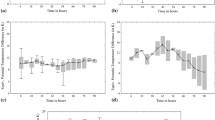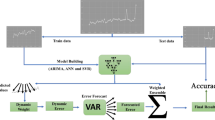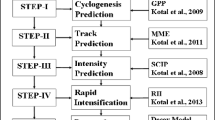Abstract
The current research anticipates develo** a model based on adaptive neuro-computation to foresee the minimum pressure drop (PD) at the centre as well as the maximum sustained wind speed (MSWS) accompanying with cyclonic systems over Bay of Bengal (BOB). The cyclonic systems taken in this work contain systems of different ranges starting from deep depression to extreme severe cyclones. For predicting PD and MSWS, suitable predictors have been sorted using factor analysis and it is observed that low-level vorticity (LLV), mid-tropospheric relative humidity (MRH) and vertical wind velocity at 850, 500 and 200 hPa pressure levels are appropriate parameters to create input matrix of neural network (NN). The adaptive NN representations are skilled with the data from 1990 to 2015 to estimate the PD as well as MSWS over BOB for 47 cyclonic systems. The outcome divulges that the multi-layer perceptron (MLP) NN model delivers decent precision at 6- and 30-h lead time in foretelling the PD. But the lowest error has been found at 6-h lead time in forecasting the central PD during mature stage of cyclonic systems. The result also illustrates that the MLP model is the utmost capable in forecasting the MSWS during mature stage of cyclonic structures with the lowest prediction error at 60-h lead time. The model results were validated and compared with the operational forecast by IMD for the 10 cyclonic systems from 2016 to 2019.















Similar content being viewed by others
Data availability
The datasets analysed during the current study are available in IMD website (http://www.rsmcnewdelhi.imd.gov.in).
Code availability
Not applicable.
References
Al-Mahasneh AJ, Anavatti S, Pratama MGM (2018) Applications of general regression neural networks in dynamic systems. In (Ed.), Digital Systems. https://doi.org/10.5772/intechopen.80258
Alpert P, Tsidulko M, Krichak S, Stein U (1996) A multistage evolution of an ALPEX cyclone. Tellus A 48:209–220
Atlas R, Hoffman RN, Ardizzone J, Leidner SM, Jusem JC, Smith DK, Gombos D (2011) A cross-calibrated, multiplatform ocean surface wind velocity product for meteorological and oceanographic applications. Bull Amer Meteor Soc 92:157–174
Baik JJ, Paek JS (2000) A neural network model for predicting typhoon intensity. J Meteorol Soc Jpn Ser II 78(6):857–869
Balaguru K, Taraphdar S, Leung LR, Foltz GR (2014) Increase in the intensity of postmonsoon Bay of Bengal tropical cyclones. Geophys Res Lett 41(10):3594–3601
Barsi A, Heipke C (2003) Artificial neural networks for the detection of road junctions in aerial images. International Archives of Photogrammetry, Remote Sensing and Spatial Information Sciences 34:113–118 ((Part 3/W8))
Bhalachandran S, Nadimpalli R, Osuri KK, Marks F Jr, Gopalakrishnan SG, Subramanian S, Mohanty UC, Niyogi D (2019) On the processes influencing rapid intensity changes of tropical cyclones over the Bay of Bengal. Sci Rep 9:3382
Brad R, Letia IA (2002) Cloud motion detection from infrared satellite images. In: Proc. Second International Conference on Image and Graphics (ICIG 2002), vol. 4875, pp. 408–412
Chaudhuri S (2010) Convective energies in forecasting severe thunderstorms with one hidden layer neural net and variable learning rate back propagation algorithm. Asia-Pac J Atmos Sci 46(2):173–183
Chaudhuri S, Middey A (2011) Adaptive neuro-fuzzy inference system to forecast peak gust speed during thunderstorms. Meteorol Atmos Phys 114:139–149
Chaudhuri S, Dutta D, Goswami S, Middey A (2013) Intensity forecast of tropical cyclones over North Indian Ocean using multi layer perceptron model: skill and performance verification. Nat Hazards 65:97–113
Chaudhuri S, Goswami S, Middey A (2014) Medium-range forecast of cyclogenesis over North Indian Ocean with multilayer perceptron model using satellite data. Nat Hazards 70:173–193
Chaudhuri S, Das D, Goswami S, Das SK (2016) Long-range forecast of all India Summer Monsoon Rainfall using adaptive neuro-fuzzy inference system: skill comparison with CFSv2 model simulation and real-time forecast for the year 2015. Clim Dyn 47(9):3319–3333
Chaudhuri S, Basu D, Das D, Goswami S, Varshney S (2017) Swarm intelligence and neural nets in forecasting the maximum sustained wind speed along the track of tropical cyclones over Bay of Bengal. Nat Hazards 87:1413–1433
Chavas DR, Reed KA, Knaff JA (2017) Physical understanding of the tropical cyclone wind-pressure relationship. Nat Commun 8(1):1–11
Chen R, Zhang W, Wang X (2020) Machine learning in tropical cyclone forecast modeling: a review. Atmosphere 11(7):676
Comrie AC (1997) Comparing neural networks and regression models for ozone forecasting. J AIR WASTE MANAGE 47:653–663
DeMaria M, Kaplan J (1994) A statistical hurricane intensity prediction scheme (SHIPS) for the Atlantic basin. Weather Forecast 9:209–220
DeMaria M, Kaplan J (1999) An updated statistical hurricane intensity prediction scheme (SHIPS) for the Atlantic and east North Pacific basins. Weather Forecast 14:326–337
Ding ZW, Li XF, Zhang J, Zhao ZQ, Xue B, Di GQ, Shen SK (2021) A theoretical analysis of unsupported roof plate and shell in excavation roadway and numerical calculation and verification of transcendental function. J Min Saf Eng 38(03):507–517
Emanuel K, Ravela S, Vivant E, Risi C (2006) A statistical deterministic approach to hurricane risk assessment. Bull Amer Meteor Soc 87:299–314
Fabrigar LR, Wegener DT, MacCallum RC, Strahan EJ (1999) Evaluating the use of exploratory factor analysis in psychological research. Psychol Methods 4(3):272–299
Gray WM (1975) Tropical cyclone genesis.Doctoral dissertation. Colorado State University, Libraries
Grimes A, Mercer AE (2015) Synoptic-scale precursors to tropical cyclone rapid intensification in the atlantic basin. Adv Meteorol 2015. https://doi.org/10.1155/2015/814043
Guhathakurta P, Rajeevan M, Thapliyal V (1999) Long range forecasting Indian summer monsoon rainfall by a hybrid principal component neural network model. Meteorol Atmos Phys 71:255–266
IMD Priliminary Report (2019) Extremely severe cyclonic storm, ‘FANI’ over the Bay of Bengal (26 April – 4 May 2019): a report government of India cyclone warning division india meteorological department New Delhi
Jang JD, Viau AA, Anctil F, Bartholomé E (2006) Neural network application for cloud detection in SPOT vegetation images. Int J Remote Sens 27(3–4):719–736
** L, Chen N, Lin ZS (1999) Study and comparison of ensemble forecasting based on artificial neural network (in Chinese). Acta Meteorol Sin 57:198–207
Kaiser HF (1960) The application of electronic computers to factor analysis. Educ Psychol Meas 20(1):141–151
Kalnay E, Kanamitsu M, Kistler R, Collins W, Deaven D, Gandin L, Iredell M, Saha S, White G, Woollen J, Zhu Y, Chelliah M, Ebisuzaki W, Higgins W, Jaccnowiak J, Mo KC, Ropelewski C, Wang J, Leetmaa A, Reynolds R, Jenne R, Joseph D (1996) The NCEP/NCAR 40 - year reanalysis project. Bull Amer Meteor Soc 77:437–471
Kotal SD, Roy Bhowmik SK (2011) A multimodel ensemble (MME) technique for cyclone track prediction over the North Indian Sea. Geofizika 28(2):275–291
Kotal SD, Bhattacharya SK, Roy Bhowmik SK (2019) Estimation of tropical cyclone intensity and location over the North Indian Ocean-a challenge. Met Application 26(2):245–252
Lanza PA, Cosme JM (2002) A short-term temperature forecaster based on a state space neural network. Eng Appl Artif Intell 15:459–464
Law KT, Hobgood JS (2007) A statistical model to forecast short-term Atlantic hurricane intensity. Weather Forecast 22:967–980
Lawrence E, Garba EJ, Malgwi YM, Hambali MA (2022) An application of artificial neural network for wind speeds and directions forecasts in airports. European Journal of Electrical Engineering and Computer Science 6(1):53–59
Lee TL (2009) Prediction of typhoon storm surge using artificial neural network. Adv Eng Softw 40:1200–1206
Martínez F, Frías MP, Pírez-Godoy MD, Rivera AJ (2022) Time series forecasting by generalized regression neural networks trained with multiple series. IEEE Access 10:3275–3283
Mohanty UC, Osuri KK, Tallapragada V, Marks FD, Pattanayak S, Mohapatra M, Gopalakrishnan SG, Niyogi D (2015) A great escape from the Bay of Bengal ‘Super Sapphire-Phailin’ tropical cyclone—a case of improved weather forecast and societal response for disaster mitigation. Earth Interact 19(17):1–11
Mohanty S, Nadimpalli R, Mohanty UC, Mohapatra M, Sharma A, Das AK, Sil S (2020) Quasi-operational forecast guidance of extremely severe cyclonic storm Fani over the Bay of Bengal using high-resolution mesoscale models. Meteorol Atmos Phys 22:1–8
Mohapatra M, Sharma M (2019) Cyclone warning services in India during recent years: a review. Mausam 70(4):635–666
Mohapatra M, Nayak DP, Sharma RP, Bandyopadhyay BK (2013a) Evaluation of official tropical cyclone track forecast over north Indian Ocean issued by India Meteorological Department. J Earth Syst Sci 122(3):589–601
Mohapatra M, Sikka DR, Bandyopadhyay BK, Tyagi A (2013b) Outcomes and challenges of Forecast Demonstration Project (FDP) on landfalling cyclones over Bay of Bengal. Mausam 61(1):1–12
Montgomery MT, Nicholls ME, Cram TA, Saunders AB (2006) A vortical hot tower route to tropical cyclogenesis. J Atmos Sci 63:355–386
Na Y, Na B, Son S (2021) Near real-time predictions of tropical cyclone trajectory and intensity in the northwestern Pacific Ocean using echo state network. Clim Dyn 13:1–7
Nadimpalli R, Osuri KK, Mohanty UC, Das AK, Kumar A, Sil S, Niyogi D (2019) Forecasting tropical cyclones in the Bay of Bengal using quasi-operational WRF and HWRF modeling systems: an assessment study. Meteorol Atmos Phys 132(5):1–17
Osuri KK, Mohanty UC, Routray A, Kulkarni MA, Mohapatra M (2012) Sensitivity of physical parameterization schemes of WRF model for the simulation of Indian seas tropical cyclones. Nat Hazards 63(3):1337–1359
Osuri KK, Mohanty UC, Routray A, Mohapatra M, Niyogi D (2013) Real-time track prediction of tropical cyclones over the North Indian Ocean using the ARW model. J Appl Meteorol Climatol 52(11):2476–2492
Osuri KK, Nadimpalli R, Mohanty UC, Niyogi D (2017) Prediction of rapid intensification of tropical cyclone Phailin over the Bay of Bengal using the HWRF modelling system. Q J R Meteorol Soc 143:678–690
Reynolds RW, Smith TM, Liu C, Chelton DB, Casey KS, Schlax MG (2007) Daily high-resolution-blended analyses for sea surface temperature. J Clim 20:5473–5496
Sarkar I, Chaudhuri S, Pal J (2021) Artificial intelligence in forecasting central pressure drop and maximum sustained wind speed of cyclonic systems over Arabian Sea: skill comparison with conventional models. Meteorol Atmos Phys 133(3):803–822
Secretariat of the World Meteorological Organization (2010) Tropical cyclone operational plan for the Bay of Bengal and the Arabian Sea, p92
Sharoni SM, Md Reba MN, Hossain MS (2021) Tropical cyclone wind speed estimation from satellite altimeter-derived ocean parameters. J Geophys Res Oceans 126(4):e2020JC016988
Singh P (2018) Indian summer monsoon rainfall (ISMR) forecasting using time series data: a fuzzy-entropy-neuro based expert system. Geosci Front 9(4):1243–1257
Singh D, Singh V (2007) Impact of tropical cyclone on total ozone measured by TOMS–EP over the Indian region. Curr Sci 93(4):37–42
Singh K, Panda J, Osuri KK, Vissa N (2016) Progress in tropical cyclone predictability and present status in the north indian ocean region. In Recent Developments in tropical cyclone dynamics, prediction, and detection. IntechOpen. https://doi.org/10.5772/64333
Sun T, Liu C, Lin C, Hsieh S, Huang C (2009). A radial basis function neural network with adaptive structure via particle swarm optimization. In (Ed.), Particle Swarm Optimization. IntechOpen. https://doi.org/10.5772/6763
Tory KJ, Montgomery MT, Davidson NE (2006) Prediction and diagnosis of tropical cyclone formation in an NWP system. Part I: The critical role of vortex enhancement in deep convection. J Atmos Sci 63:3077–3090
Vickery PJ, Skerjl P, Steckley AC, Twinsdale L (2000) Simulation of hurricane risk in the United States using an empirical storm track modeling technique. J Struct Eng 126:1222–1237
Wahiduzzaman M, Yeasmin A (2019) Statistical forecasting of tropical cyclone landfall activities over the North Indian Ocean rim countries. Atmos Res 227:89–100
Wang P, Wang P, Wang C et al (2022) Using a 3D convolutional neural network and gated recurrent unit for tropical cyclone track forecasting. Atmos Res 269:106053. https://doi.org/10.1016/j.atmosres.2022.106053
Wilson I, Paris S, Ware J, Jenkins D (2002) Residential property price time series forecasting with neural networks. Knowl-Based Syst 15:335–341
Xu W, Balaguru K, August A, Lalo N, Hodas N, DeMaria M, Judi D (2021) Deep learning experiments for tropical cyclone intensity forecasts. Weather Forecast 36(4):1453–1470
Yang YQ, Wang JZ (2005) An integrated decision method for prediction of tropical cyclone movement by using genetic algorithm. Sci China (d) 48:52–68
Yang Y, Wang P, Gao X (2022) A novel radial basis function neural network with high generalization performance for nonlinear process modelling. Processes 10(1):140. https://doi.org/10.3390/pr10010140
Yesubabu V, Srinivas CV, Hariprasad KBRR, Baskaran R (2014) A study on the impact of observation assimilation on the numerical simulation of tropical cyclones JAL and THANE using 3DVAR. Pure Appl Geophys 171(8):2023–2042
Zhang Z, Yang X, Shi L, Wang B, Du Z, Zhang F, Liu R (2022) A neural network framework for fine-grained tropical cyclone intensity prediction. Knowledge-Based Systems 108195
Acknowledgements
The corresponding author acknowledges the Space Application Centre, ISRO, India, for providing the opportunity to participate in the SCATSAT 1 Application programme. The authors gratefully acknowledge the anonymous reviewers for constructive comments which helped to improve the clarity of the manuscript.
Author information
Authors and Affiliations
Contributions
All authors contributed to the study conception and design. Jayanti Pal and Ishita Sarkar performed the analyses and wrote the paper. All authors read and approved the final manuscript.
Corresponding author
Ethics declarations
Ethics approval
Not applicable.
Conflict of interest
The authors declare no competing interests.
Additional information
Publisher's note
Springer Nature remains neutral with regard to jurisdictional claims in published maps and institutional affiliations.
Rights and permissions
About this article
Cite this article
Sarkar, I., Chaudhuri, S. & Pal, J. Forecasting pressure drop and maximum sustained wind speed associated with cyclonic systems over Bay of Bengal with neuro-computing. Theor Appl Climatol 149, 1255–1276 (2022). https://doi.org/10.1007/s00704-022-04112-6
Received:
Accepted:
Published:
Issue Date:
DOI: https://doi.org/10.1007/s00704-022-04112-6




